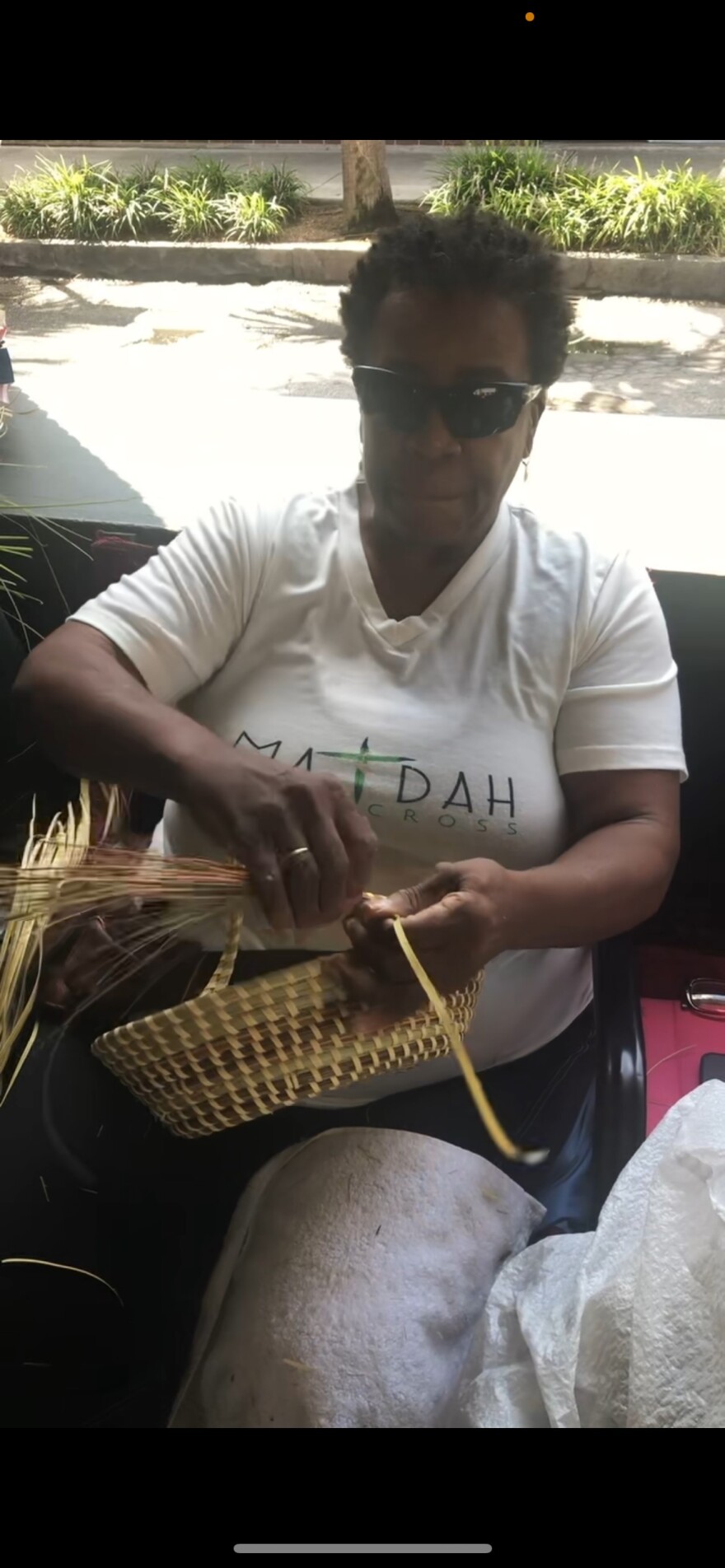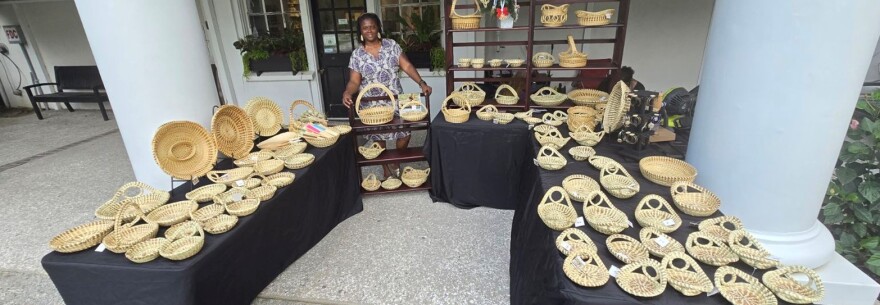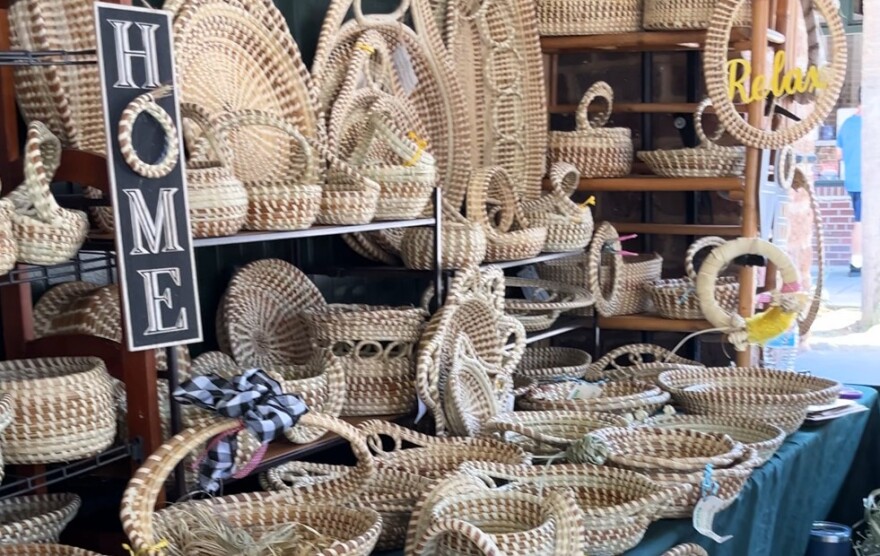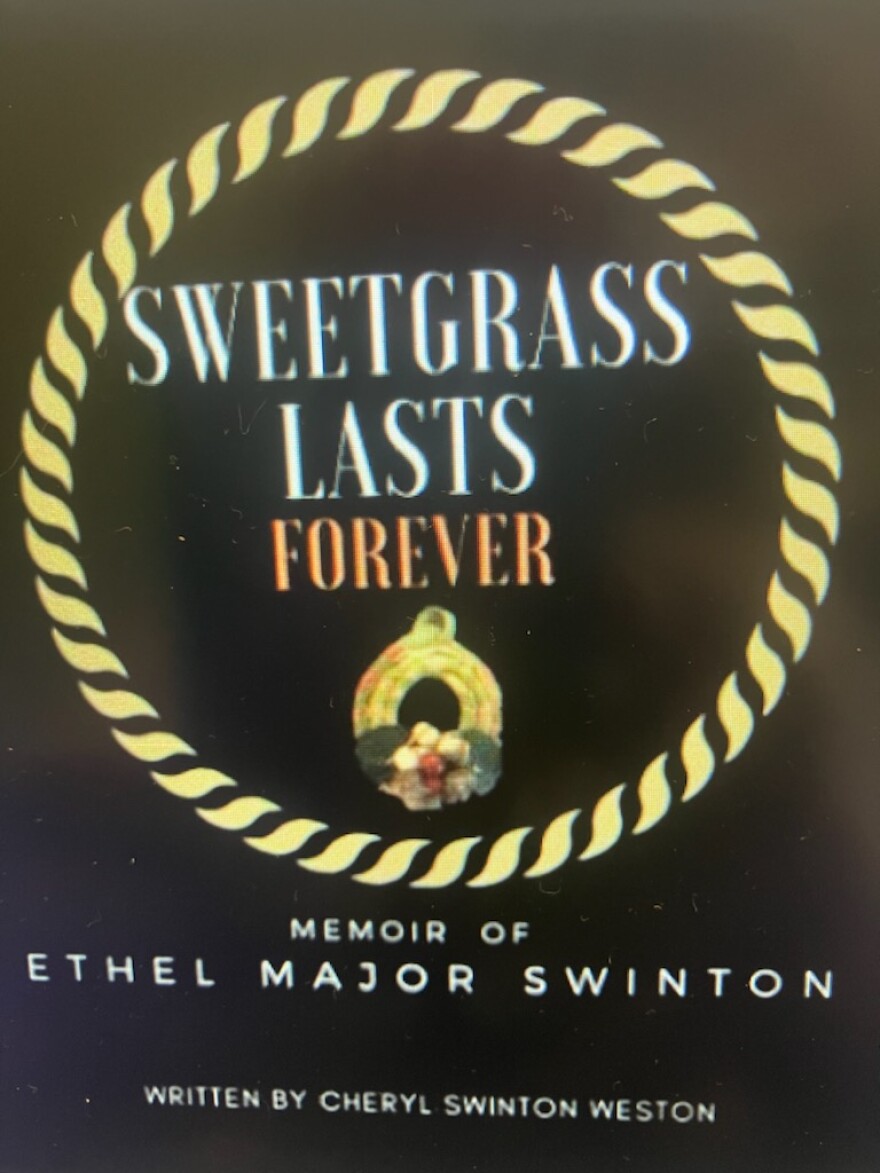This Saturday, Charlotte will experience a slice of South Carolina’s Lowcountry region, a historically and culturally rich area along the state’s coast. During the Lowcountry Culture Festival at Ballantyne’s Backyard, people will be able to sample Frogmore Stew, red rice and other Lowcountry dishes filled with fresh spices and vegetables. The music of the region, vibrant crafts and artwork associated with the area’s Gullah Geechee people will be on display. Sweetgrass basket makers, Jennifaye Singleton of Huger, South Carolina near Charleston and Cheryl Weston of Mount Pleasant, South Carolina, will be on hand to demonstrate their art form, brought by enslaved people from West Africa to the Lowcountry. They talk to WFAE’s Gwendolyn Glenn about the craft and how it was passed down to them.
Cheryl Weston: I was taught at the age of 17. I didn’t really want to do it. You know how parents make you do things you don’t want to do at the time. I was a phlebotomist for 34 years, and I only did it when I needed extra money. It really helped me out when I was between jobs. But it wasn’t until I got like in my 40s, I began to do it more. I see the beauty in it and I see the value in it, not just monetary but in self-worth in our culture.
Gwendolyn Glenn: Now who taught you?
Weston: My mom taught me. We weren’t born into it. She married into it. That’s how it came in our family.
Glenn: And I understand that your mother used to sell her baskets at the downtown market. Was she inside or outside? Because I remember when I used to visit years ago, I would see a lot of the Black basket sellars outside, not inside the market.

Lowcountry Culture Festival
Cheryl Weston of Mount Pleasant makes sweetgrass baskets in the market in downtown Charleston. Her mother rented the space in the early 1970s.
Weston: I could remember back in the early ’70s, my mom started out on the sidewalk. The basket weavers — we called them weavers then, but it’s sewers now — they didn’t get the option to get tables. They had to only get the sidewalk space and I could remember it was only like $3 or $4 a day for the space. As years went by, they began to offer the sweetgrass weavers a chance to rent the table. A lot of the weavers were skeptical because it costs more but I can remember my mom being the first one to pay that $12 a day for a table. We’re still there all these years later.
Glenn: Now, were you not allowed to get tables because of racism?
Weston: I guess that’s what it was and it was hot, but then, you know, back in the day we just wanted to get our foot in the door.

Lowcountry Culture Festival
Jennifaye Singleton of Huger, near Charleston has been making sweetgrass baskets since she was 7 years old. She will have her baskets on display at the Lowcountry Culture Festival in Charlotte at Ballantyne Backyard.
Glenn: Jennifaye, let me bring you in. Jennifaye Singleton, also talking to us from Charleston. Tell me when did you start making baskets and who taught you?
Jennifaye Singleton: I started when I was about 7 years old because my aunt wove baskets and so she taught me how to do the basics of the baskets.
Glenn: You were so young then, so what did you love about it?
Singleton: It was just something different. It was something in an art form that comes from grass. So, if I can make something out of grass, let me try. So, when you first start out, it was a bird’s nest (that you made) but as you progress and as you practice and as you keep going, you know, it turns into this beautiful art piece and you amaze yourself. So, I kept going.
Glenn: Did you do it full time or do you have another full-time job?
Singleton: This is all I do. I do sweetgrass baskets. I travel with the baskets. I also travel with my storytelling and I have books and dolls and different things that I travel with and they all fit under one umbrella because it’s keeping the culture alive and passing it on to the next generation in different venues.

Lowcountry Culture Festival
Cheryl Weston makes sweetgrass baskets of all shapes and sizes. They can sell from $10 for small Medah Crosses to more than $3,000 for larger baskets. Weston will give a demonstration at the Lowcountry Culture Festival in Charlotte.
Glenn: Well, let me ask both of you this, when you were young, did you go out into the fields to pick the grass yourself and are you still doing that today?
Singleton: I do. I started going out to get the grasses not until I was about 16 years old when I was able to drive and now I can actually show you probably five different kinds of grass that we do have from here to Florida.
Glenn: And it’s all called sweetgrass?
Singleton: They’re sweetgrass, but they, you know, have different names according to the strength of the grass, course grass or soft grass. You have the wine grass, the wire grass. So, it all depends on what area you find it in. It has different names for the grasses.
Glenn: Oh, OK. And I thought it was just one. Cheryl, what about you as a child? Did she go in the fields to pick your grass and are you still doing that?
Weston: I used to go with my mom in the fields to cut the bulrush. Bulrush is one of the things that some artists put in the basket, but it’s made of sweetgrass, bulrush, long pine needle and Palmetto. It helps with the coloring of the baskets. We don’t use any dyes or any colors. The bulrush can either be red, they can be black, or it can have like a brown tint to it.
Sweetgrass growing in a section of the garden of the International African American Museum in Charleston
Glenn: When I was in Charleston, there was a gentleman who I would always see at the courthouse, outside on the sidewalk, and he said he was having a hard time finding sweetgrass. And he said that you didn’t tell where you got yours from, it was a guarded secret. Is that still a problem because so much development has taken over a lot of the fields I understand.
Singleton: There’s still a problem. We’re working on trying to find stable places to plant them now so that we can have sweetgrass for the coming generation.
Weston: You have young men and some young women, they go out and gather it and they sell it to us. Some will bring it to me at the market sometimes. I’m 67 now and I just can’t go out and gather it anymore. I used to like doing it, you know, when I was younger.
Glenn: How important is it to you to pass this down to the younger generation so it doesn’t disappear?
Singleton: It’s important to pass it down to the next generations. It’s just hard to pass it down to the generation because this generation is the technology generation and they really don’t want something hands on or want to do something hands on. I have three boys that I’m raising and my oldest can make a basket from top to bottom. My 18-year-old son would rather do the Palmetto roses versus the basket and then my 15-year-old, he did a basket maybe every three months and then that’s it. That’s all you’re gonna get from him.
Weston: My two girls, who are 36 and 34, I taught them since they were 5. Now they went away from it, but now they’re beginning to do it again. Now to keep it in my family, my nieces and nephews, we get on the porch at my sister’s house and we have a family page, and I’m always putting up pictures of us sewing baskets on the porch so they can be encouraged and be motivated to maybe come on the porch with us sometime.
Glenn: Now both of you will be at the Lowcountry festival. What kinds of baskets will both of you be bringing? Let’s start with you, Jennifaye.
Singleton: I’m going to bring my elephant ears. I’m going to bring some four corners bread baskets and fanner baskets.
Glenn: For people who have never seen the elephant ear baskets, describe that.
Singleton: So, it’s a round basket and you go up the sides of the basket and it looks like its steps going up the side, but it also looks like floppy ears on an elephant.
Glenn: What about you, Cheryl? What will you be bringing?
Weston: I have some of the same, but I have ornaments made of Medah Crosses and baskets and large and small reefs.
Lowcountry Culture Festival
The sweetgrass basket making art form was brought to the Lowcountry by enslaved people from West Africa.
Glenn: These baskets many years ago were not just made for decoration and for people to buy but had practical uses correct?
Singleton: Before they were art pieces, a lot of the plantations had them on the plantations because they used them to go in the fields and pick the cotton, the beans, the okra and anything else that they needed to pick. They were used as utilitarian pieces for vegetables or eggs and bread baskets like the fanner basket is used to winnow rice.
Glenn: What does that look like?
Singleton: It’s a flat basket, with a little lip on it. It can be as big as 24 to 36 inches, depending on how big you want to make it, and they would put the rice in the basket and they would toss it in the wind as they husked it in the wind, the shell and the hull and everything would fall off with the rice and the rice would settle to the bottom of the basket.
Glenn: Could you both briefly tell me what do you want people to take away who come to the festival? What do you want them to learn?
Singleton: Learn a little bit of our culture. It’s not just about sweetgrass because sweetgrass is a part of our culture and it goes into pretty much everything we do as Gullah Geechee people.
Weston: I want people to take away that this is art and that sweetgrass is something we can make something beautiful out of it, do amazing things with it. I believe it’s a gift from God.

Sweet grass basket maker Cheryl Weston, who will be in Charlotte for the Lowcountry Culture Festival, has written a book about how her mother used the art form to provide for their family and leave a cultural legacy that continues today.
Sweetgrass basket sewer Cheryl Weston has written a book about how her mother generated income and left her family a cultural inheritance through her sweetgrass baskets. It is titled Sweetgrass Lasts Forever: Memoir of Ethel Major Swinton.
Weston and Jennifaye Singleton will be at Saturday’s Lowcountry Culture Festival, sponsored by QCity Metro, in partnership with the Charlotte International Arts Festival. Lowcountry Culture Festival is a WFAE sponsor.
Source link : http://www.bing.com/news/apiclick.aspx?ref=FexRss&aid=&tid=66e4715d03224790ae212e09fb87c7f3&url=https%3A%2F%2Fwww.wfae.org%2Frace-equity%2F2024-09-13%2Ffestival-highlights-the-culture-and-history-of-south-carolinas-lowcountry&c=6231659201811487995&mkt=en-us
Author :
Publish date : 2024-09-13 05:38:00
Copyright for syndicated content belongs to the linked Source.


